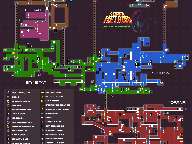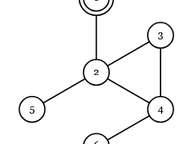Every once in a while, you encounter a new mechanic or system, that let's you rethink aspects of how you run games.
Such a revelation came to me in the form of Sites from Mythic Bastionland (the quickstart rules are free on itch.io). But what are Sites?
In essence, a Site is are a collection of locations that are connected with paths. You could think of them like a pointcrawl. There's unfortunately not much more definition given in the core rules of Bastionland, so there is some room for interpretation.
Locations and Paths
In the easiest sense - and the way I first interpreted it - each location can be seen as a room in a dungeon. Each path is the connection from each of these rooms - be it a door or a hallway. That is certainly one aspect of it. But that does not cover all of it.
A location can just as easily be a whole area in a dungeon. For example a prison with multiple cells, a guard room etc. This can also be expanded outward. The inside of a hex can just as easily be represented by a Site. Different landmarks will represent the locations.
Similarly the paths are not a direct connection from room to room, but is just some path that connects the two locations. This can be a door, but can also be more elaborate, such as an underground river. A path just means that you can get from one location to the other via this path.
Sites are fractals
A location could also be a Site itself. So if you have a multi-level dungeon, you can represent each level as a site and connect them together. This makes Sites recursive - a fractal.
Let's take as an example the map of Super Metroid.
| Location | Legend |
|---|---|
| 1 | Wrecked Ship |
| 2 | Crateria |
| 3 | Maridia |
| 4 | Brinstar |
| 5 | Tourian |
| 6 | Norfair |
You can represent the 6 major areas as a Site. But similarly you could create a Site for each of the areas. So a Site can represent the full map of Norfair or Maridia etc.
Applications
Dungeons
Representing dungeons is the first and obvious application of Sites. This is how I first used Sites. But that was back, when I didn't see the full picture.
Instead of having one huge dungeon (which certainly would work as well), I would now have a bunch of "normal" Sites (meaning 6 locations) interconnected via another Site (if it is a multi-level dungeon).
A huge dungeon, for example, was previously 37 locations. But this neatly goes into 6 Sites (minus 1 location, but that's okay).
Theming can now be applied on each (Sub-)Site. This is similar to the Super Metroid map above. Each of the areas has its own theme.
As a side bonus, since a Site normally consists of 6 locations, you could easily apply techniques such as 5 Room Dungeon.
Sub-Hexes
One example that is also given in the core rules, is using Sites for sub-hexes. My system is already bound to 6 landmarks within a hex anyway, so a Site gives a clean way on how the hex has to be navigated.
So for an example, you could be on a mountain hex. One location would be the base of the mountain (which is the entrance) and another the top. These are connected via a path (naturally). There's also a secret path to a mountain cave, that houses a dungeon.
So when you want to go to that cave, you first have to enter the hex via the base of the mountain and then use the secret path. You can't go directly to the cave from another hex. This resolves a bit the problem of where do you actually enter a hex (and how do you leave it).
Similarly you have to go back to the entrance of the hex if you want to leave. So this works well together with the Tension Pool - as you can't just "quickly" leave a hex, when things don't go your way. You have to invest some time to reach the "entrance" and thus complications could arise.
Hacking the Rules
The core rules actually encourage to do so. One thing you can play with, is the number of locations. I would not go over 6, but you can certainly try Sites that are smaller. I'm going to use that, for the Sub-Hex Crawling. I don't want 6 landmarks every time.
The other thing is to rethink the distribution of the different types of locations. The default is 3 features, 2 dangers and 1 treasure (which I interpret as Opportunity). But you can easily go 3 dangers, 2 treasures and 1 feature. Or go full chaos mode and roll for each location separately (1-in-3 chance for each of the types).
The same goes for the type of paths.
Going forward
There's one sentence in the core rules, that I want to follow a bit more going forward.
Sites can be created as areas that warrant more detailed exploration, [...]
Sites are an interesting concept, that integrate into my playstyle easily. There are some small adjustment needed, but I think I can make it work. I now need to play with them a bit more to really get the feel for it.
I'm really intrigued by Sites, as they make my life as GM a lot easier. I don't have to draw elaborate maps, but can use very simple symbols and rules to still make (hopefully) interesting things. They area a very abstract way to display relations between locations.
Have a look yourself and try them out. I was positively surprised, maybe you are too.

